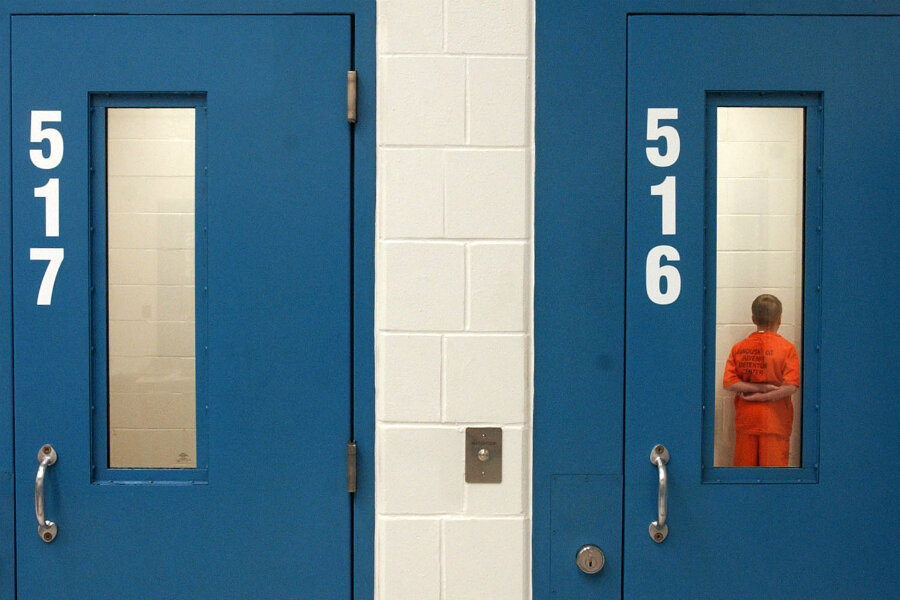Indiana child re-sentenced for murder: A sign of juvenile justice reform?
Loading...
Paul Gingerich was 12 years old when he helped fatally shoot a friend's stepfather in a small Indiana town about 45 miles northwest of Fort Wayne. The boys had planned to flee to Arizona or California after the ambush, but both were caught, convicted, and sentenced to 25 years in prison.
The case sparked outrage from child welfare advocates because Mr. Gingerich, now 18, is believed to be the youngest person in Indiana history to be sentenced in an adult court. More than five years later, the case has spurred reforms that are part of a nationwide shift in how America metes out juvenile justice – and mercy.
For Indiana, that shift came in 2013 with the passage of Paul's Law, named after the baby-faced boy in the mug shot that ran in newspapers alongside sobering accounts of the murder. Thanks to that law, Gingerich was back before a judge in Kosciusko County on Friday, when he was handed a new, lighter sentence for the heinous crime he committed during a particularly impressionable period of his childhood.
"I know I committed a truly horrible crime and I am sorry for that," Gingerich said in court, as The Indianapolis Star reported. "I will never stop being sorry and I know sorry will never be enough."
The idea behind Paul's Law – which is among a growing number of similar measures across the United States – is to give judges an opportunity to review the progress made by juvenile convicts while in custody. Gingerich, who has been held in a juvenile facility since his sentencing in 2011, faced the prospect of a lengthy stay in an adult facility as well, but because he has demonstrated good behavior, earned good grades, and participated in therapy sessions behind bars, he could find himself living with his mother again within four months.
The revised sentence calls for a few more years of post-release electronic monitoring followed by a decade of probation, so if his current trajectory continues, the young man who spent the entirety of his teenage years in custody could spend the entirety of his adult life on the outside. That's the sort of restoration that child advocates say the juvenile justice system should be striving for, and it's the sort of work that can be accomplished only if the system acknowledges that children are not adults.
"All parents know and adolescent development research proves that children are fundamentally different than adults," Jody Kent Lavy, executive director of the Washington-based Campaign for the Fair Sentencing of Youth, tells The Christian Science Monitor. "They are more prone to risk-taking behavior, more susceptible to peer pressure, and they are uniquely capable of rehabilitation. And I think we see all of those things in Paul’s case."
Ms. Lavy, whose campaign works with state legislatures to implement reforms, had no hand in pushing Paul's Law, which aims to ensure that young people face consequences for their criminal actions without losing sight of their capacity to change. But she sees the measure as part of the broader reform effort taking root as Americans begin to recognize the flaws of their tough-on-crime past policies.
"I think there’s a growing recognition that we need to hold our children accountable in age-appropriate ways," Lavy says. Her organization has assembled a network of nearly 50 men and women who were reformed after being incarcerated for murder as children: "living proof of the unique capacity for change that resides within every child."
As emerging scientific research has revealed a failure by the current criminal justice systems to appropriately grapple with normal transitions from childhood into adolescence then on into adulthood, policymakers have mulled handling certain adult cases involving defendants much older than Gingerich as juveniles. Gov. Dannel Malloy (D) of Connecticut, for instance, has pushed a proposal to raise the juvenile justice cutoff to age 21.
While different jurisdictions throughout the country are experimenting with different approaches, they collectively are engaged in what could be described as another major reformation of America's treatment of children in criminal court.
In 1899, the first juvenile court was established in Cook County, Ill., ushering in a first wave of reforms across the country. Before then, children had typically been brought before adult courts just like everyone else, but by 1925, all but two states had a distinct justice system for juveniles, systems designed to focus on rehabilitating the individual offender instead of on doling out punishment for particular offenses, as the MacArthur Foundation noted last year in a juvenile justice status report. A second wave of reforms came in the 1960s, when the US Supreme Court acknowledged due process rights of children, including the right to legal counsel and the right against self-incrimination.
As violent crime among American youth began to rise in the mid-1980s and continue into the 1990s, however, the public grew concerned about particularly violent young people, whom Princeton University professor Jon Dilulio described in 1995 as "super-predators" that could be tamed only by religion and mass incarceration, as the MacArther report explained. Although the super-predators myth, which smeared some children as "godless fatherless monsters," has been roundly debunked, many of the tough-on-crime measures enacted by state legislatures at the time are still in force, Lavy says.
But the current wave of reforms is finally beginning to dismantle the fear and punishment-focused policies of recent decades, Elizabeth Clarke, president and founder of the Juvenile Justice Initiative in Cook County, tells the Monitor.
"I think the call for reform in this country is becoming much louder and stronger," she says.
Over the past 12 years, the rate of juveniles committed to prison or another correctional facility dropped by 53 percent, a decline accompanied by slumping violent crime rate among youth as well, according to the Pew Charitable Trusts, as the Monitor reported last year.
Even so, Ms. Clarke says the United States is alone among developed nations in its practice of trying juveniles in adult courts, a practice she described as "morally reprehensible," leaving much room for improvement. She sees Paul's Law and efforts like it as signs of progress, albeit incremental.
"It's a very small step in the right direction, but it still leaves us way behind the way any other developed nation treats its children," Clarke says.
Limited measures like Paul's Law do not address bigger problems with the American criminal justice systems, which exhibit racial disparities nationwide. That's why Lavy, whose organization expects to work with five to 10 state legislatures next year, says she remains interested to see how authorities in Indiana apply Paul's Law to children of color.






